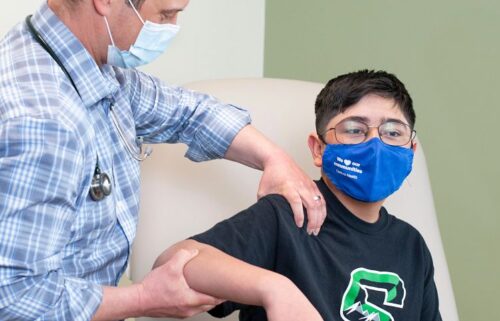‘This disaster is not over’: Post-flooding perils endanger Vermont as more rain could inundate already deluged cities
By Holly Yan, Lauren Mascarenhas and Nouran Salahieh, CNN
(CNN) — The catastrophic floodwater that damaged or destroyed countless homes in Vermont is slowly receding, but a spate of new threats loom.
“This may not be over. With rain in the forecast – and nowhere for it to go – we could see waters rise again,” Vermont Gov. Phil Scott said Wednesday.
The National Weather Service issued a new round of flood watches for parts of New England – including devastated swaths of Vermont – starting Thursday.
“Additional rainfall is expected Thursday afternoon as a line of strong thunderstorms move through,” the National Weather Service in Burlington said.
It’s still not clear exactly how many homes and businesses have already been ravaged by the flooding spawned by epic rainfall earlier this week.
“We are still in active response mode and have multiple rescues ongoing,” Vermont Public Safety Commissioner Jennifer Morrison said Wednesday. More than 200 people have been rescued since Sunday, she said.
While no deaths have been reported from the flooding, the governor estimated thousands of lives have been upended.
“I know thousands of Vermonters have lost homes, businesses and more, ” Scott said. “The devastation is far reaching.”
The good news: “Generally speaking, rivers have crested, and river flooding should wind down throughout the day,” Morrison said Wednesday. But, she added, “This disaster is not over in the state of Vermont.”
In addition to the risk of more flooding Thursday, residents of submerged homes face a host of new perils.
“Many disaster-related deaths occur after the acute phase and during the cleanup and recovery,” Morrison said.
“Those returning to their flooded homes should take precautions when entering. Do not turn on your circuit breaker or use any power sources until you’ve had your system checked by a licensed electrician,” she said.
“For those with damaged property: Please report your damages to 211, as we are collecting data for a possible federal disaster declaration.”
The head of the Federal Emergency Management Agency visited Vermont to survey the damage and urged residents to be aware of post-flooding dangers.
“It takes just 6 inches of water for someone to be wiped off their feet,” FEMA Administrator Deanne Criswell said Wednesday. “And in that water, we see a lot of debris. We see downed power lines. We see things that can cause additional damage.”
‘My house has been an island in a river’
In Barre, Vermont, a torrent of water and mud-deluged neighborhoods.
“It just came all pouring through here,” Barre resident Laura Camus told CNN affiliate WPTZ. “My house has been an island in a river this whole time.”
Adding to the misery, Camus said she doesn’t live in a flood plain, so she and her neighbors don’t have flood insurance.
The worst-hit areas of Vermont include Barre, Ludlow, Londonderry, Andover and the state capital, Montpelier – where the normally bustling downtown district was eerily deserted, except for the occasional canoeist padding down the street.
in Montpelier, the owners of gear and apparel shop Onion River Outdoors quickly realized they wouldn’t be able to clean up the flood damage they endured on their own. So they asked for volunteers.
And dozens came out to help owners Jen and Kip Roberts clean up the mess.
Video shared with CNN shows volunteers using shovels to clean flood damage in the street as others pressure wash mud-caked walls inside. Machines are heard sucking up water from the flooded basement level and pumping it outside.
Salvageable merchandise was placed in bins or on tables outside.
“It is more of a family than a business in many ways,” Onion River Outdoors social media manager Kathryn Lovinsky told CNN. “They are incredibly generous with their time and in charitable contributions to the community. It’s not a surprise that so many community members have come out to help.”
The recovery could take ‘years – if not a decade’
President Joe Biden has approved an emergency declaration for the state of Vermont, authorizing FEMA to move in needed equipment and resources, the White House said Tuesday.
New Hampshire sent swift boat rescue crews and Black Hawk helicopters to assist in Vermont, Gov. Chris Sununu said. And teams from Connecticut, Massachusetts and North Carolina are already in the state providing assistance, authorities said.
Even with all the help, “this is going to be a years – if not a decade – long recovery for the state of Vermont,” said Morrison, the state’s public safety commissioner.
Andrew Molen, a restaurateur who owns several businesses in Ludlow, told CNN at least one of his restaurants was devastated by Monday’s flash flooding and another will need two months of repairs to reopen.
“The water almost reached the ceiling. We took a big hit this time,” Molen said. “The good thing is no one was injured.”
The public safety commissioner credited the lack of fatalities to “Vermonters’ common sense” and emergency crews for their “life-saving work during this disaster.”
But those who lost their homes or businesses face an arduous journey ahead. Morrison encouraged any volunteers interested in helping with the recovery to visit vermont.gov/volunteer.
Why these disasters could get worse
Steady warming and atmospheric changes are “supercharging” regular weather events, making them longer and more intense, said Michael E. Mann, a climate scientist and distinguished professor at the University of Pennsylvania, told CNN.
Climate experts say a “perfect storm” is leading to deadly flooding in places like the Northeast while other parts of the world – including the Southwestern US – are scorched by record-breaking heat.
Sen. Peter Welch of Vermont said he wanted to know how much climate change may have played a role in the catastrophic flooding in his state.
“I talked to the head of NOAA (National Oceanic and Atmospheric Administration) yesterday and asked him that question,” Welch said at a news conference Wednesday.
“And as has been reported, the warmer weather – particularly over the ocean – that then comes across the country and is here in Vermont, means that there’s much, much more moisture in the air,” Welch said. “All that moisture in the air turns into rain.”
Flashbacks to Hurricane Irene
Scenes of neighborhoods inundated with muddy water, residents paddling through streets and sunken roadways have evoked memories of 2011’s Hurricane Irene.
Irene hit the United States as a hurricane in August 2011 and left entire communities submerged, killing more than 40 people in several Eastern states.
This week’s intense storms left floodwaters in some areas that “surpassed levels seen during Tropical Storm Irene,” Vermont’s governor said.
Montpelier was hammered by 5.28 inches of rainfall Monday, the National Weather Service in Burlington said. That’s more than any other day on record – including when Irene dropped 5.27 inches of rain on the state capital on August 28, 2011.
“Irene had about a 12-hour duration of rain, and then it was over,” the governor said. “This is different. We’ve had like 48 hours of steady rain.”
The-CNN-Wire
™ & © 2023 Cable News Network, Inc., a Warner Bros. Discovery Company. All rights reserved.
CNN meteorologists Dave Hennen and Taylor Ward and CNN’s Sara Smart, Kristina Sgueglia, Caroll Alvarado, Jessica Xing, Jillian Sykes and Artemis Moshtaghian contributed to this report.



